Text
What are the different types of plastics labeled on containers? How do we differentiate them?
0 notes
Text
Deforestation in the Amazon Rainforest and Its Role in Climate Change

Photo:
Deforestation poses a major threat to the ecosystems living in the Amazon Rainforest as well as climate change on our Earth. The Amazon Rainforest provides nearly
0 notes
Text
Can Aquaculture Be Sustainable for Our Environment with the Right Approach?

Aquaculture--the method of farming saltwater and freshwater fish, shellfish, and aquatic plants--has become a reliable system over the past few decades for alleviating the world food demand, providing fish for consumption without overfishing, allowing economic relief for fishermen, rebuilding endangered species, etc. This practice has been widely used to better maintain the declining ocean fish population by creating farming approaches such as open-net pens, pond systems, closed systems, raceways, recirculation systems, suspended aquaculture, submersible net pens, etc. Additionally, aquaculture has relieved some fishermen's economic strain by providing coastal community jobs and lessening the need to overfish.
However, the many types of farms can vary with their risk to the environment and how controlled the areas are. Many farms can damage the outside waters because of potential contaminants in contact with specific systems. In contrast, some farms have less invasive methods and can be more sustainable with suitable regulations and ongoing improvements.
Various Farming Methods
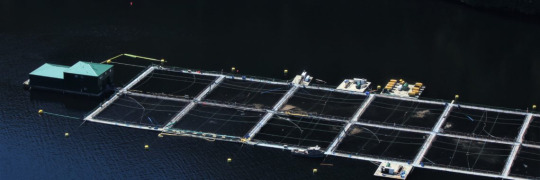
Photo: Kelly Roebuck, open-net pen in BC
Open-net pens (cages) are placed directly into the water and moored at the bottom surface of the ocean, usually containing saltwater fish such as Atlantic salmon, trout, bluefin tuna, etc. They allow for contact between the farm and the outside environment, which risks the leakage of waste and chemicals, transfer of diseases, and escaping fish from damage to the cages. This threatens wild juvenile fish that may be interbred with farmed fish, which may transmit disease and alter the local gene pool. Not only that but without any regulation of pesticides and waste, the water that flows freely through the ocean and into the cages is not a controlled factor.
Watershed Watch Salmon Society Senior Scientist Stan Proboszcz reveals, "The fact of the matter is that many migrating fish have no choice but to pass by these farms.” This indicates the unavoidable encounter between farmed fish and wild fish in an open system.
Closed containment systems "use a barrier to control the exchange between farms and the natural environment." Some closed systems include ponds, tanks, recirculation technology, or raceways to limit the interaction with the outside habitat and are primarily used for freshwater species such as abalone, tilapia, and shrimp.
Pond culture is a popular method used in coastal Asian countries, with the area where fish reside contained in a small enclosed space in the ground. Species are raised, and feed is added to maintain their diet. Wastewater containing nitrogen and phosphorus used as fertilization for phytoplankton growth as a natural food base and other components such as bacteria, algae, and chemicals should be adequately filtered when discharged to be environmentally noninvasive. When unfiltered, it can lead to groundwater pollution in the outside environment.
Mangrove forests on the coast of Asian countries have been depleted because of alterations made to accommodate these fish and shrimp farms. The World Resources Institute evaluates that “nearly half the land now used for shrimp ponds in Thailand was formerly used for rice paddies; in addition, water diversion for shrimp ponds has lowered groundwater levels noticeably in some coastal areas.” This issue demonstrates the damaging effect of the need to create more shrimp ponds at the cost of natural mangrove ecosystems, salinization of soil and water, discharge of effluents resulting in pollution of the pond system and receiving waters, and misuse of chemicals. To combat this issue, the restoration and protection of mangrove habitats should be managed along with regulations regarding pond effluents, chemical use, and regional cooperation.
Recirculation technology cycles water through filtration processes and returns it to the aquaculture system. This process aids in maintaining water quality in natural waterways by minimalizing the potential for fish escapes, disease transmission, and pollution.
A semi-closed system exchanges the wastewater used in ponds for fresh natural water from outside sources. This method does not treat the water like recirculation technology but instead pumps out unfiltered water into the environment, which only increases pollution and damage to other fish.
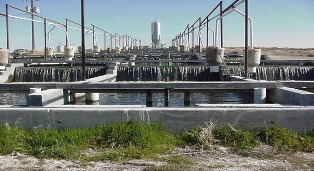
Photo: Gary Fornshell, University of Idaho, flow-through tilapia farm near Boise, Idaho
Raceways are relatively straight, narrow, shallow tanks that need high water flow to sustain the aquatic life, usually rainbow trout, catfish, or salmon, raised there. They require large amounts of flowing water diverted from natural streams, streams, or wells to provide a high-quality water source. The main issue with raceways is the high release of effluents from fish fecal matter and uneaten feed, which flows into the receiving body of water.

Photo: Santryl, PEI oyster farm CC BY-NC 2.0
Suspended aquaculture uses cages, nets, or mesh bags with a rope to attach and drop shellfish such as oysters, scallops, mussels, or clams into a body of water. This method of vertically suspending shellfish only requires clean water and steady water flow to decrease the potential waste buildup. If the species is native to the environment as well, it can be a low-risk form of fish farming, and shellfish can naturally filter feed, allowing them to help restore waterways.
Although there are more aquaculture methods, the methods described above are the most popular ones that can cause low-risk or high-risk environmental damage. Some potential risks to the natural habitat that some farms pose have created a worry for environmentalists who believe that these intensive methods prioritize the output of fish while minimizing the input of resources to grow while harming the fish's lifestyle and environment economically. If fishing farms implement new and innovative solutions while continuing the minimally invasive methods, the future of aquaculture could be beneficial in further creating food security without causing irreparable damage.
Solutions
Some solutions to decrease the environmental impacts of aquaculture reside on multiple factors. In general, careful planning of the location, shipping, and aquaculture method by fisheries could lessen the impact. However, more specifically, to combat the issue of mangrove forest depletion, the restoration and protection of mangrove habitats should be managed along with regulations regarding pond effluents, chemical use, and regional cooperation. In other cases, research should be done to minimize waste matter in water before pumping it out into other water sources in recirculating methods. With the same thought in mind, new research should apply to different systems of cleaning wastewater instead of allowing it to contaminate surrounding areas. This way, methods directly contacting the ground or natural water sources can be more sustainable with their waste outputs. Another idea scientists have discussed is using an integrated cultivation system where fish such as finfish, oysters, sea cucumbers, and kelp are farmed together to take less space and have shellfish species that can clean the surrounding environment that has built up waste. Not only will this minimize space, but also help the effluents discharged.
The Ocean Foundation has composed an article discussing the effects of aquaculture along with some research scientists have done, as well as possible solutions. Their efforts and others, such as the National Oceanic and Atmospheric Administration, have created findings that will lessen the harmful effects of aquaculture, hoping for sustainable ways to provide food security and alleviate poverty.
Sources
youtube
#climate change#climate justice#earth#environment#environmentalism#epa#environmetalists#aquaculture#Youtube#fish
2 notes
·
View notes
Text
Green Building: The Path to Sustainable Architecture

According to the U.S. Environmental Protection Agency, "buildings account for 39% of total energy use, 12% of the total water consumption, 68% of total electricity consumption, and 38% of the carbon dioxide emissions" in the United States. This demonstrates the over-encompassing effects of buildings in general on climate change issues. Not only does this affect our environment's health, but also the issues surrounding carbon dioxide emissions on human health because of its damage to our bodies in different ways.
To battle this issue, forward-thinking architects, environmentalists, ecologists, and designers have been constructing infrastructures with environmental aspects in mind for the past few decades. This practice is called green building, which is the outcome of structures using environmentally responsible, eco-conscious designs and resource-efficient processes throughout a building's complete life cycle from siting to design, construction, operation, maintenance, renovation, and deconstruction. By using sustainable operations, green buildings are decarbonizing real estate, reducing energy and waste, conserving water, prioritizing safer materials, and lowering exposure to toxins by using sustainable operations and construction, aiming to amplify the positive and mitigate the adverse effects on the environment and climate.
The USGBC and LEED
The United States Green Build Council (USGBC), founded in 1993, seeks to promote designing and constructing buildings that are environmentally responsible, profitable, and healthy places to live and work. The USGBC hopes "to transform how buildings and communities are designed, built and operated" so that the environment can better sustain itself to be healthy and prosperous.
The Leadership in Energy and Environmental Design (LEED), an organization under the USGBC, was established in 1998 to offer a rating system for green buildings that scores different structures on how sustainable and environmentally green they are.
The USGBC's mission is to create buildings that "reduce contribution to global climate change, enhance individual human health, protect and restore water resources, protect and enhance biodiversity and ecosystem services, promote sustainable and regenerative material cycles, and enhance community quality of life." By advocating for this, they allow for a healthier environment that sustains for much longer with green buildings as opposed to a building that does not conserve energy, eliminates the natural habitat, and does not make use of natural resources.
What requirements classify a green building?
With the LEED association, a building can receive one of four types of certification classifications (Certified, Silver, Gold, or Platinum) based on 9 credit categories:
Integrative Process:
Location and Transportation
Sustainable Sites
Water Efficiency
Energy and Atmosphere
Materials and Resources
Indoor Environmental Quality
Innovation
Regional Priority
Each category has its specific point system that gives a building points for their sustainable efforts in different aspects of the environment. The point category for the certifications is as follows:
Certified (40–49 points)
Silver (50–59 points)
Gold (60–79 points)
Platinum (80+ points)
LEED helps promote eco-awareness within buildings that better the health of humans and the environment for the long-term sustainability of buildings that improve and maintain their natural ecosystem.
Is it better to create new green buildings or implement green aspects in a sustaining building?
With already sustaining buildings that don't have eco-friendly methods in place, it is better to keep that building but change the interworkings of it instead of demolishing it, using new resources, and creating more waste when building a new one. By implementing new practices in existing buildings, we can cut down the newly sourced materials for construction and the time spent planning the layout. Although creating sustainable processes without pre-planning may be more complex, it will decrease the carbon footprint of the building with future practices.
Some ways sustainable practices are utilized in green buildings:
Using building materials that contain post-consumer recycled content
Placing the building site with the concern for the natural environment and its features in mind
Reutilizing wastewater
Using rapidly renewable materials, such as bamboo, cotton, wool, and denim scraps
Reusing salvage materials from construction, demolition, or land clearing as a new building material
Generate electricity on-site
Green buildings offer cost-saving possibilities, energy-saving practices, and innovative technology to ensure that the built environment can sustain itself for ever-growing urban planning buildings. This step towards a more eco-friendly earth will help lessen the carbon footprint created by infrastructures.
Sources
#climate change#climate justice#earth#environment#environmentalism#epa#green#green building#green life#ecology#ecofriendly
1 note
·
View note
Text
The Issues Surrounding Lithium-Ion Battery Production and Disposal

The increasing demand and production of electric vehicle batteries have become unsustainable for the Earth's ecological welfare and human populations because of their extraction process and afterlife disposal. As the auto industry continuously advances with electric cars, the market for rechargeable batteries increases, with Lithium-ion batteries (LiB) becoming the most commonly used rechargeable batteries. LiB features a secondary cell construction allowing their lifespan to provide the highest energy density and hefty charge/discharge cycles, making them widely used for electrical devices requiring a long battery lifespan. However, for multiple reasons, lithium-ion battery production and its inefficient afterlife disposal have become environmentally and socially unsustainable.
With lithium production, mining sites worldwide threaten the ecosystems and communities outside the areas because of greenhouse gas emissions, excessive water use, and the destruction of livable land. Mining sites use approximately 500,000 liters of water to extract one ton of lithium during the extraction process while spreading heavy metals and chemicals to the surrounding environment, which contributes to air and water pollution. Using livable land as a mining site loses the biodiversity and culture of those areas by compromising wildlife with battery chemicals, infiltrating rivers and streams with dangerous metals, and releasing toxic chemicals into the air.
Alongside the environmental repercussions, people working in these mining sites are underpaid, overworked, and in unsafe working conditions since they are usually located in areas without government regulation. As working conditions remain hazardous, water and air pollution also affect communities by creating health risks, such as burns, neurological damage, and cancerous disabilities.
After its production, manufactured lithium-ion batteries risk deteriorating below functional levels after numerous uses, prompting consumers to dispose of them improperly. Researchers say only 5% of used Li-ion batteries are recycled in the United States. As people toss batteries into the trash, they end up in landfills, making the area prone to fires and explosions years after. The Li-ion batteries can also release toxic components into the soil and surrounding bodies of water, making it difficult for all living organisms to sustain themselves.
These batteries' end-of-life disposal should not end up in household recycling or garbage bins because they can be a possible fire hazard but instead discarded at a local battery recycling location. Even with recycling, there is a danger for recycling trucks transporting, handling, and discharging battery waste since they can ignite other materials because of their explosive properties in high temperatures.
However, despite the hazards associated with every part of a lithium-ion battery's life cycle, actively trying to recycle them at a separate recycling or hazardous waste collection point. This way, there can be preventative measures in place to eliminate harming the environment while scientists and researchers look for more ways to be more sustainable with battery production and consumption.
Sources
Zhao, E., Walker, P. D., Surawski, N. C., & Bennett, N. S. (2021). Assessing the life cycle cumulative energy demand and greenhouse gas emissions of lithium-ion batteries. Journal of Energy Storage, 43, 103193. https://doi.org/10.1016/j.est.2021.103193
#climate change#climate justice#earth#environment#environmentalism#epa#batteries#renewableenergy#reusedmaterials#lithium#environmetalists
4 notes
·
View notes
Text
The Fast Fashion Industry and Its Environmental Costs

With the ever-changing fashion trends circulating on social media and the affordable prices in stores, the fast fashion industry has continued to grow over the past decade with quick online deliveries, rapid clothing production, and overconsumption of clothing items. Many companies within the fashion industry have opted to have their manufacturers overseas for cheap labor to avoid the high minimum wages enforced by developed nations. Although more affordable garments are now accessible to low-income people, it also comes with the cost of ecological destruction and humane indecency.
Forced Labor for profits
Many companies such as Shein, Forever 21, H&M, Urban Outfitters, and Zara use sweatshops, workplaces with socially unacceptable conditions that pay low wages to produce low-cost clothing items. Although these companies can maintain a low price tag on their products, they become part of the unsustainable practices of fast fashion because of underpaid labor, poor working conditions, and a longing contribution to plastic production. By consistently shopping from these brands, many support the unsustainable practices that are the backbone of these companies. Instead, choosing to shop at thrift stores, only buying clothes when necessary, reusing old clothing items, thinking before purchasing, and creating a capsule wardrobe, a set of clothes that can be worn interchangeably, can reduce the need to support the production of these companies.
Materials used
When companies want to profit while manufacturing clothing, they tend to choose low-cost artificial synthetic fibers such as polyester, rubber, and nylon, which take more energy to produce than natural fibers such as wool, cotton, and bamboo. Natural fibers have a lower environmental impact throughout manufacturing because they do not require as many chemicals as synthetic fibers. When choosing what clothing garments to buy, purchasing the ones manufactured with natural fibers is more beneficial to our environment because they can break down quickly in nature.
Polluted waters and excessive water use
The fashion industry is one of the most water-intensive industries because it uses water to spin, dye, and finish the textile. Its use of dye has contributed to the wastewater dumped into our streams, rivers, and oceans, which can spread toxic chemicals to marine ecosystems.
Plastic microfibers
Not only is the pollution of waters happening before the sale of items, but after customers buy clothes, the presence of microfibers that detach when it is in the washer goes into wastewater that will eventually reach our oceans, further polluting them. With filtration as the only laborious and expensive way to remove microplastics, it becomes unsustainable and remains in the ocean. It ends up in the human food chain through agricultural communities and sea life, ultimately causing adverse health effects.
Textile waste
As fashion trends constantly change with the modern age of technology and fast fashion's affordability, many garments are discarded and donated not long after purchase. Although donating might seem like a better, more sustainable way to recycle clothing, it might end up in landfills regardless if not sold. According to the Ellen Macarthur Foundation, "it is estimated that people are buying 60 percent more clothes and wearing them for half as long." This practice has only increased over time, allowing truckloads of textiles to be dumped into landfills or incinerated every second. To better maintain our clothes, one should be more conscious about purchases by deciding if a clothing piece has the potential to be worn multiple years after its purchase, lessening the need to throw away or donate so often.
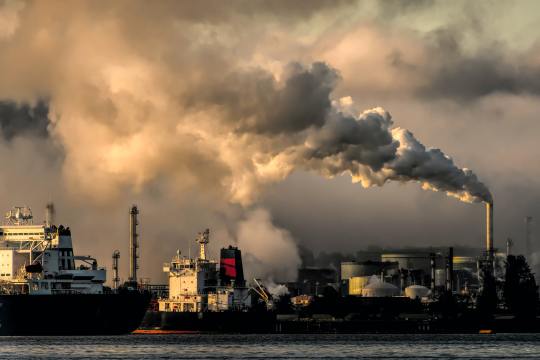
Carbon emissions
With the production and incineration of clothing items, carbon emissions are released into the air, causing public health dangers to communities around factories. The World Bank says, "The fashion industry is responsible for 10 % of annual global carbon emissions, more than all international flights and maritime shipping combined." With new technologies that try to capture the pollutants, "they remain present and often are turned into a dangerous substance," which will pollute our air regardless.
Solutions
With the overwhelming amount of affordable clothing items that are ecologically damaging, being more conscious is always a way to reduce the effects of consumerism. It is ultimately up to us, consumers, to beware of the adverse impacts of supporting unsustainable brands and find eco-friendly companies that put the planet first. Some sustainable brands to shop from are:
Patagonia
Raven + Lily
The Classic T-Shirt Company
Cou Cou Intimates
My Mum Made It
Avani
Good Guys
Shopsoftlana
L'Envers
Pela
Sources
#climate change#earth#environment#environmentalism#epa#climate justice#fast fashion#carbon emissions#carbon footprint#microplastics
9 notes
·
View notes
Text
The Impacts of Pollution on Human Health
Waste generation in low/high-income areas and its impacts.
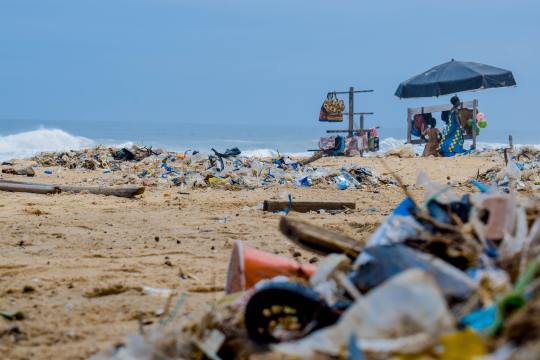
It is not a secret that plastic and toxic chemical pollution due to improper waste disposal in our environment threatens our health and safety. In many places, garbage cannot be properly disposed of because of unsustainable waste disposal systems, which will pollute the water, soil, and air. Waste dumpsites, especially in rural low- and middle-income communities worldwide, are at their highest with unregulated trash. Most of the unregulated plastic pollution on land will eventually seep into the soil, and others will find their way down to bodies of water, infiltrating ocean ecosystems. Due to the inaccessibility of a reliable waste management system, many people in these communities suffer from exposed methane and carbon dioxide emissions, diseases, microplastics, and pollutants.

Although the waste output of low- to middle-income communities will be much less than those in high-income neighborhoods, without a well-funded waste management system and access to compostable, biodegradable, environmentally friendly products, their society will remain in plastic waste. Regardless, many of these communities try to eliminate the garbage by uncontrolled burning and waste dumping, but these methods are not sustainable for themselves or the Earth's future.
Burning plastic trash instead of properly disposing of it or using techniques to limit the waste output, such as recycling or reusing, will result in black carbon and poor air quality, elevating the risk of respiratory diseases, cancer, and death. According to the Pan American Health Organization, nearly "7 million premature deaths are attributable to air pollution in 2016," and "about 88% of these deaths occur in low and middle-income countries."
Waste dumping results in plastic pollution in the environment, which "pose both physical (e.g., entanglement, gastrointestinal blockage, reef destruction) and chemical threats (e.g., bioaccumulation of the chemical ingredients of plastic or toxic chemicals sorbed to plastics) to wildlife and the marine ecosystem."
Though their methods may not be feasible in the long run, only government environmental programs and agencies can enact real change in these communities with funded systems and innovative ways to transport trash in and out of rural areas. Education on composting, reducing, reusing, and recycling may also help create a better environment.
Despite the large amounts of pollution attributed to the low- and middle-income communities' unsustainable waste systems, the continual plastic pollution is mostly because of the high production of plastic in growing industries in China, North America, and Europe. With easy access to waste-generating goods, the pollution problem becomes more prevalent in these countries. This foreshadows other factors that play a role in the plastic pollution issue, such as the illegal dumping of plastic waste, littering, and mismanagement of plastics; in 2016, the United States ranked #1 in plastic waste generation, as shown in the photo below.
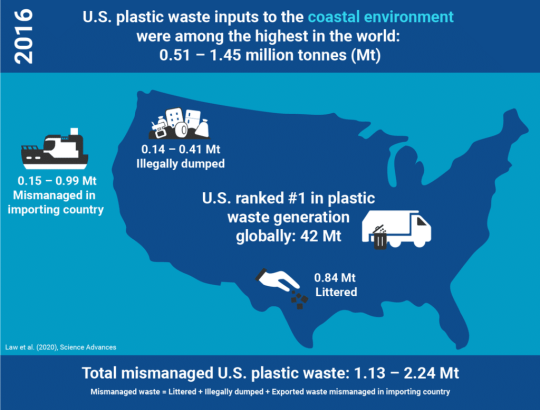
Source: NPG, 2020
With the ever-growing amount of mismanaged plastic disposed of in our environment, the effects continue to show in research studies, revealing that it threatens the health of humans globally.
The diagram created by CIEL below demonstrates the multitudes of ways that exposure to pollution can affect human health.
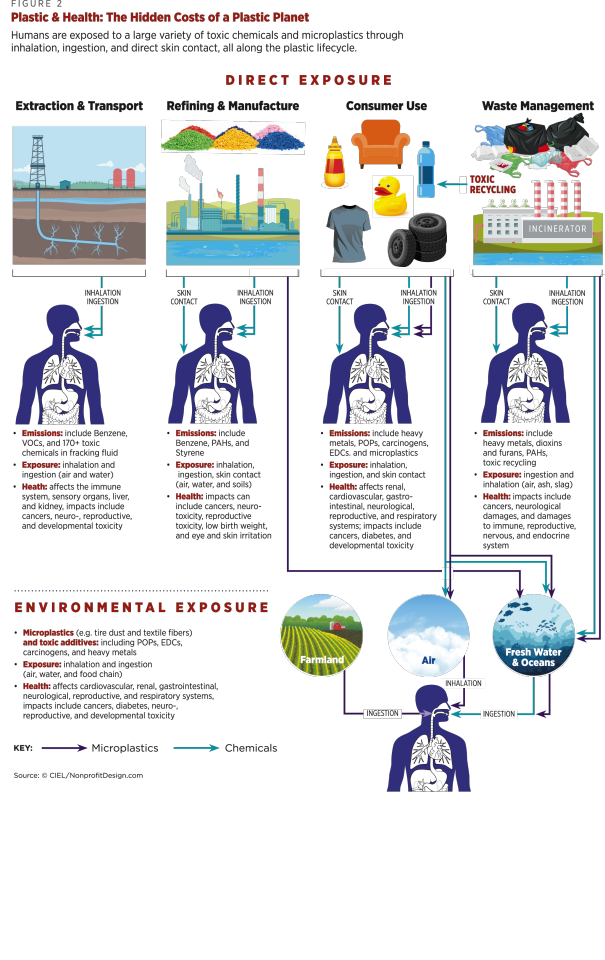
More than ever, we should beware of its effects and stop producing single-use plastics that will only create more problems when disposed of. Learning and educating ourselves on Earth and becoming aware of the adverse effects will allow us, as a community, to grow one step closer to a more sustainable planet.
Sources
Mihai, F., Gündoğdu, S., Markley, L. A., Olivelli, A., Khan, F. R., Gwinnett, C., Gutberlet, J., Meidiana, C., Elagroudy, S., Ishchenko, V., Penney, S., & Lenkiewicz, Z. (2022). Plastic Pollution, Waste Management Issues, and Circular Economy Opportunities in Rural Communities. Sustainability, 14(1), 20. https://doi.org/10.3390/su14010020
Vinti, G., & Vaccari, M. (2022). Solid Waste Management in Rural Communities of Developing Countries: An Overview of Challenges and Opportunities. Clean Technologies, 4(4), 1138-1151. https://doi.org/10.3390/cleantechnol4040069
Zhou, B., Qi, F., Riaz, M. F., & Ali, T. (2022). An Analysis of the Factors behind Rural Residents’ Satisfaction with Residential Waste Management in Jiangxi, China. International Journal of Environmental Research and Public Health, 19(21). https://doi.org/10.3390/ijerph192114220
#climate justice#epa#environmentalism#earth#environmetalists#environment#enviromental#climate change#reduce reuse recycle
13 notes
·
View notes
Text
The 3 R's of Waste Management
Reduce, reuse, and recycle.
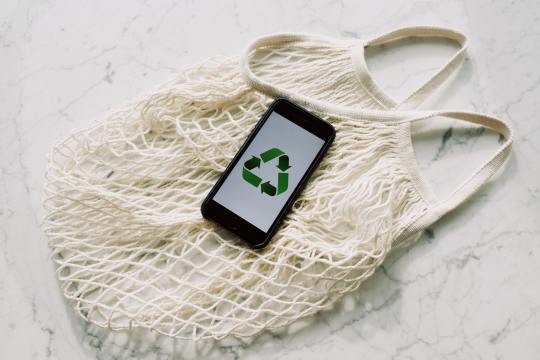
The 3 R's are the necessary foundations of conservation and waste management techniques for a more sustainable lifestyle.
Sustainability, in its environmental definition, is the ability to maintain conditions supporting biological life on Earth by preserving natural resources. The continued prevalence of diminished natural resources due to the rise in greenhouse gas emissions, such as carbon dioxide and methane, from human activity over the past decades has impacted our course of sustainability on planet Earth. However, reducing, reusing, and recycling materials will lessen energy consumption instead of mining, extracting, and producing new goods with raw materials. These forms of waste management will allow trees to be planted in areas to lessen the carbon dioxide in the atmosphere that would otherwise be used as landfills for trash.
Reduce
Overconsumption of products that yield mass amounts of trash can contribute to the problem that waste management is trying to fix. Being aware of the issue at its roots and diminishing the need to throw away items can better sustain and handle the waste output that one is producing. Reducing the amount of discarded waste can also lessen the need to reuse or recycle items constantly.
Some ways to reduce and use preventative measures are to:
use reusable forms of everyday daily items such as reusable beeswax food wraps, washable utensils, electric lighters, metal razors, and recycled grocery bags
compost compostable foods at compost centers in your state
shop at zero-waste grocery stores in your state
avoid throwaway items such as single-use cutlery and dishes
replace paper items with fabric or cloth options such as fabric napkins, dishcloths, and cotton paper towels
buy products in bulk as opposed to small, single-use containers

Reuse
Often, it can be easy to discard packaging or items that no longer work or have a use for them. Instead, one should put creativity into practice when thinking of ways to reuse an object instead of throwing it out entirely and increasing waste output.
Some ways to reuse common thrown-away items are to:
turn used milk, coffee, juice, and water cartons into birdhouses
grow seedlings in empty egg cartons
use empty plastic milk jugs for your garden in creative ways
clean out glass jars or containers and repurpose them as a storage component
sell or donate old clothes, furniture, appliances, etc., to those who can use it
reuse grocery bags to cover small trashcans or on your next trip to the store
utilize newspaper as a way to cushion fragile items for storage
use leftover wood as fuel for bonfires
donate old notebooks and books for children who are in need of them
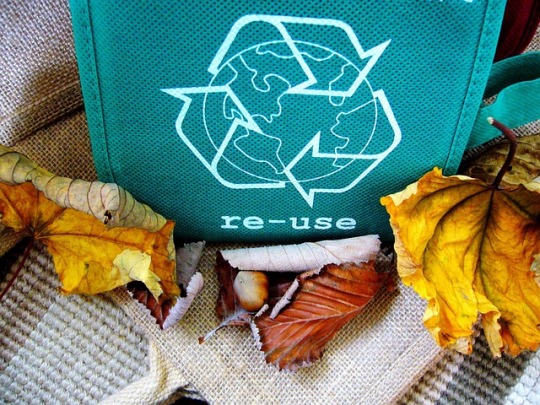
Recycle ♻️
At times, it can be easier to throw away used goods rather than recycle them and allow them to redirect potential waste from landfills, conserve energy, and reduce the need to extract new materials for new products. According to the EPA, "recycling one ton of paper would save enough energy to power the average American home for six months, save 7,000 gallons of water, save 3.3 cubic yards of landfill space, and reduce greenhouse gas emissions by one metric ton of carbon equivalent (MTCE)."
Some ways to get started with recycling items can be to:
buy items that are made with recycled materials so that once it is used up, you can recycle them and restart the process
educate yourself on the plastic recycling symbols and learn what they mean and if they can be recycled
be aware of the fact that not all plastics can be recycled at certain facilities
clean out hazardous/unrecyclable contents before recycling items
choose to buy things that are made with water-soluble solutions instead of chemical-based solvents
look out for materials that local recycling facilities are accepting, and start collecting recyclable items
use public blue bins that indicate if they accept paper, glass, or plastic for an easy-access recycling system
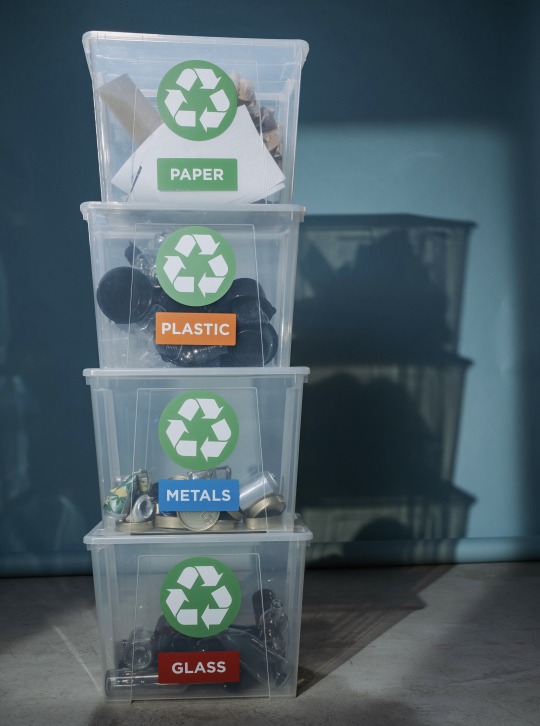
Efforts to start being sustainable might seem to make a slight difference amongst the tons of trash thrown away daily, but having one person reuse, reduce, and recycle, can make a big difference in a healthier Earth.
Sources
“3rs - Reduce, Reuse & Recycle.” SustainableSA.Com, 2 Aug. 2016, www.sustainablesanantonio.com/practices-technology/reduce-reuse-recycle/.
“Basic Information Details | Paper Recycling.” United States Environmental Protection Agency, 21 Feb. 2016, archive.epa.gov/wastes/conserve/materials/paper/web/html/index-2.html.
“Climate Change Indicators.” United States Environmental Protection Agency, 1 Aug. 2022, www.epa.gov/climate-indicators/greenhouse-gases.
“Climate Change, Recycling, and Waste Prevention.” Climate Change, Recycling and Waste Prevention from King County’s Solid Waste Division - King County, kingcounty.gov/depts/dnrp/solid-waste/programs/climate/climate-change-recycling.aspx. Accessed 1 July 2023.
Fahad. “3 R’s of Environment - Reduce, Reuse, Recycle.” Earth Reminder, 4 Jan. 2020, www.earthreminder.com/3rs-of-environment-reduce-reuse-recycle/.
#environment#recycle#reduce#earth#epa#environmentalism#climate change#climate justice#recycle reuse renew rethink#reusedmaterials#reduce reuse recycle#ecofriendly#sustainability#sustainable#recycled#environmetalists
8 notes
·
View notes